
Meet us at Bengaluru Tech Summit in Hall No. - 1, Booth no. - C58

AI is already here and will be here for years and years to come. The best part is that it will be upgraded to a better version every passing day. And it will keep getting better and better.
You must have seen now how people are actively using AI tools these days, and one of the famous examples would be ChatGPT. So, what’s shifting this change? What’s making people so reliant on gen AI tools? Well, it’s not just about one industry that we are talking about; we’re talking about each and every industry present out there. And, when it comes to upskilling, AI has earned that feather in its hat as well.
A key indicator of this momentum is that the global AI in Learning and Development market is projected to reach around USD 97 billion by 2034.

The AI in Learning and Development market is experiencing immense growth, driven by the escalating demand for personalized learning solutions. This market’s expansion is particularly fueled by the need for continuous skill enhancement and adaptability within the dynamic job market. The primary driver of growth in the AI-driven L&D market is the rising demand for personalized learning pathways. But what if AI never came into the picture? How would traditional L&D have looked? Let’s compare the two scenarios.
In today’s cut-throat corporate world, learning and development (L&D) departments are facing a lot of pressure to quickly upskill and reskill their workforce as knowledge nowadays becomes obsolete at lightning speed. Normally, L&D has been using instructor-led training (ILT), static eLearning modules, and once-a-year compliance refreshers.
But with the rise of AI, smart, data-driven learning ecosystems are taking the place of these old-school methods. This revolutionary advance marks the divide between the conventional and AI in Learning and Development models, a change that, apart from the content delivery, is also altering the very understanding and operation of learning.
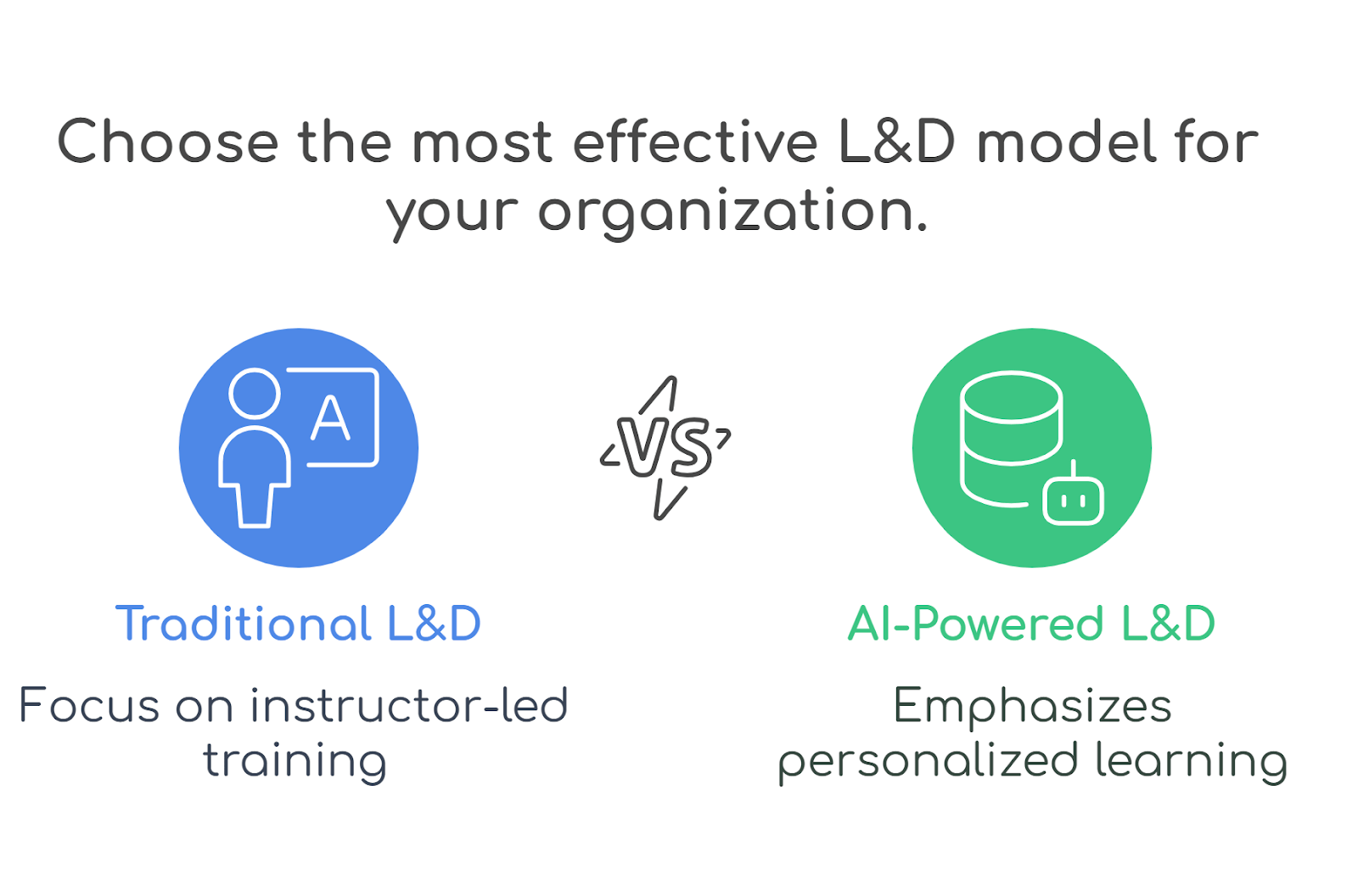
The major characteristics of traditional L&D models are their relatively high degree of stability, hierarchical nature, and one-size-fits-all conformance. Instruction is one-directional, with the gleaned learning taking place through the use of uniform curricula, often in a classroom or through low-tech digital platforms. Assessments are summative, and the feedback provided is scarce. This old-style education may be functional in a corporate environment that is less volatile, but it is generally seen as being ineffective, tiring, and mismatched to individual learning patterns.
The great majority of traditional training programs are neither very adaptable nor easily personalized, implement inflexible schedules, and are far from being updated in real time. These factors not only prevent the learner from a thorough understanding of the material and obtaining context-specific skills but also question the quality of the learners’ product. Furthermore, traditional L&D approaches often evaluate efficiency by means of out-of-date metrics such as seat time and course completion rates, the information from which gives the instructor little insight into actual knowledge retention or performance impact.
The marriage of AI with learning and development is by far a significant reformation in the quest for unmatched accuracy, target-specificity, and prediction capabilities. AI-enabled L&D models capitalize on the use of machine learning algorithms, natural language processing, and cognitive computing for the purpose of creating personalized learning paths that cater to the unique profiles of individual learners. Moreover, the fusion of these technologies not only revolutionizes content delivery but also brings significant changes to the content curation process, learning needs identification, and outcomes assessment.
The use of AI is the inception of learning and development that leads the way from reactive to proactive strategies. So, the exact utility of AI tools is not just to cope with but also to foresee, of course. It is through these AI tools that we are able to tap into rich data resulting from performance reviews, job roles, and industry trends to make a prediction.
Well, when it comes to traditional L&D models and AI-powered L&D models, there’s a huge difference between the two. Let’s check that out…
The traditional way of learning provides the same learning experiences for all irrespective of their capabilities, styles of learning, and the journey in their careers. But the AI systems of the present time support their users by means of newly devised algorithms which are up-to-date so that they can easily understand difficult terms and give feedback immediately if necessary, offer microlearning materials, quizzes, and resources that match the pace and preferred learning way of each learner.
For instance, AI-driven platforms are able to detect when a student is in trouble while learning and straight away can make a decision to lower the difficulty of the task, or they can transform a different way of explaining the topic. This level of customization is only realized with AI and is one of the greatest values of AI in learning and development. For teams producing training materials or internal documentation, using a structured memo format can enhance clarity and ensure important information is communicated effectively throughout various AI-driven learning initiatives.
Traditional L&D rely on people to develop content, and content production is laborious and time-consuming, and most often turns out to be out of date before it gets to the staff. AI today is a game-changer here by performing continuous content curation coming from the company’s internal knowledge base, external libraries, and real-time industry data.
AI can very well determine, combine, and refresh learning materials itself, thereby guaranteeing that employees are furnished with the most current and appropriate content. Furthermore, thanks to natural language processing, AI can not only understand the semantic meaning but also contextualize and optimize learning experiences based on the needs of a job.
The usual L&D methods fall back on after-training feedback and/or the managers’ impression, both of which are characterized as delayed and subjective. AI tools offer immediate, artificial intelligence-supported, learning and development that goes beyond merely computing and processing information. Platforms with AI give real-time analytics as one of their great features that offers comprehensive information such as a learner’s involvement, progress, and understanding of the topic. There are dashboards that can help L&D professionals to base on the data-driven decisions, make the curriculum better, and provide intervention that is more focused.
Actually, AI implements of predictive models and machine learning algorithms have made it feasible for identifying those learners that are at risk and in the process providing them with support means such as additional resources, peer collaboration, or individual tutoring.
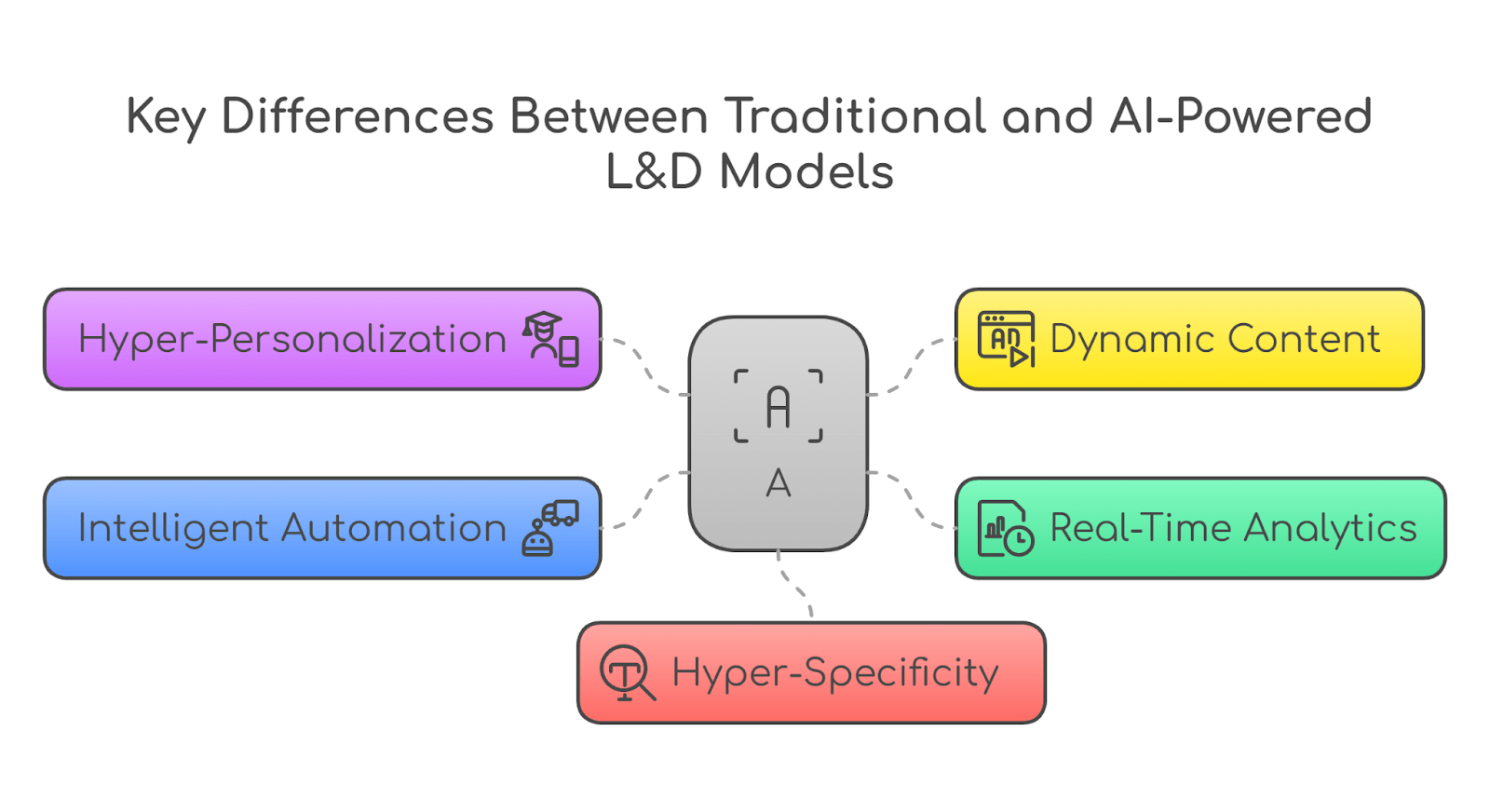
Such time-consuming administrative works as enrollment, tracking and reporting in traditional L&D leave L&D teams exhausted. AI is capable of the orchestration and management of the administrative tasks most typically related to L&D such as record keeping, tracking, and file generation. It allows the teams to concentrate on their core responsibilities and hence strategy and innovation are ready to take the stage.
As an example, smart machines can handle routine inquiries, scheduling tools that are powered by AI can organize learning events, and AI-driven recommendation engines contribute to the fact that learners can be supplied with the most relevant content. These gains make L&D more agile and scalable.
The traditional learning programs have the habit of being broad and generalized, and this indicates that their target audiences are broad as well. A new platform like the one with AI is where a company can expect its employees to be given training as detailed as the business objectives and the company’s competency model no matter how diversified they may be. AI, through its advanced data analytics capability, assigns activities in training modules to metrics of performance, thus it helps the company know what makes a difference in the whole process.
Every one of these actions reiterates the fact that L&D is an enabler of enterprise strategies, which is not just concerned with costs.
AI is like a knight in shining armor for L&D; however, people are still failing to use AI to its maximum potential. So, let’s take a look at the full potential of the role of AI in education and what AI has to offer in this industry…
Most enterprise learning strategies depend on holistic teaching. This means having the same course materials for all employees. However, not all employees are the same. Some may already have a skill that the job needs. So, forcing them to learn what they already know is not a very effective strategy.
AI in Learning and Development can analyze huge data sets and derive conclusions about employee training needs using machine learning and predictive analysis technologies. AI can also create learner profiles combining disparate data sources, which would take days if done manually. This automatically identifies the skills missing in your employees in a very short span.
This concept is already in use. Popular online training providers can use AI to measure an organization’s learner performance, skills, and knowledge gaps. Once the gap is identified, the L&D team can work on adapting their training approach to meet the knowledge gap. This makes learning more effective and doesn’t waste crucial employee hours.
These uses of AI in education, training, and development enhance the learning experience, improve the effectiveness of instruction, and provide learners with more personalized and efficient education.
AI can identify knowledge gaps and automatically scan for the most appropriate content for the learner. We all know how that works, as we have all used Google to search for information.
Just like Google, AI can scan the Internet, LMS, your proprietary content, and other sources to auto-suggest the most relevant content. This approach saves learners time, as they don’t have to manually go through multiple pages of search results for hours.
Creating educational content is time-consuming and challenging. For this reason, most enterprises outsource their content creation at a high cost. AI can help organizations save time and money.
We discussed how AI can source information snippets and digital resources from the Internet and other connected platforms. The same AI technology can also consolidate and present them in an easy-to-understand manner.
AI, through natural language processing, can even convert videos into texts. You can convert whole podcasts, webinars, and lectures into written words without any effort. This is similar to the way YouTube provides automatic subtitles in videos.
AI can personalize learning according to the pace, age, gender, and demographics of the learner. It can also gradually release materials to the employee as she/he finishes a chapter or a module.
For example, you want to train an experienced employee in customer management. AI can automatically scan the employee’s skills and skip the basic training materials to suggest advanced resources.
AI technology also aligns learning with the employee’s learning style. Research has shown that each of us learns in a different style. Men know better in some ways, while females have their own learning styles. Older adults, again, have a preferred way of learning that is not very effective for youngsters.
AI can track and identify employee learning styles and optimize the learning experience for the best results. Personalized learning leads to greater retention, higher recall, and improved learning.
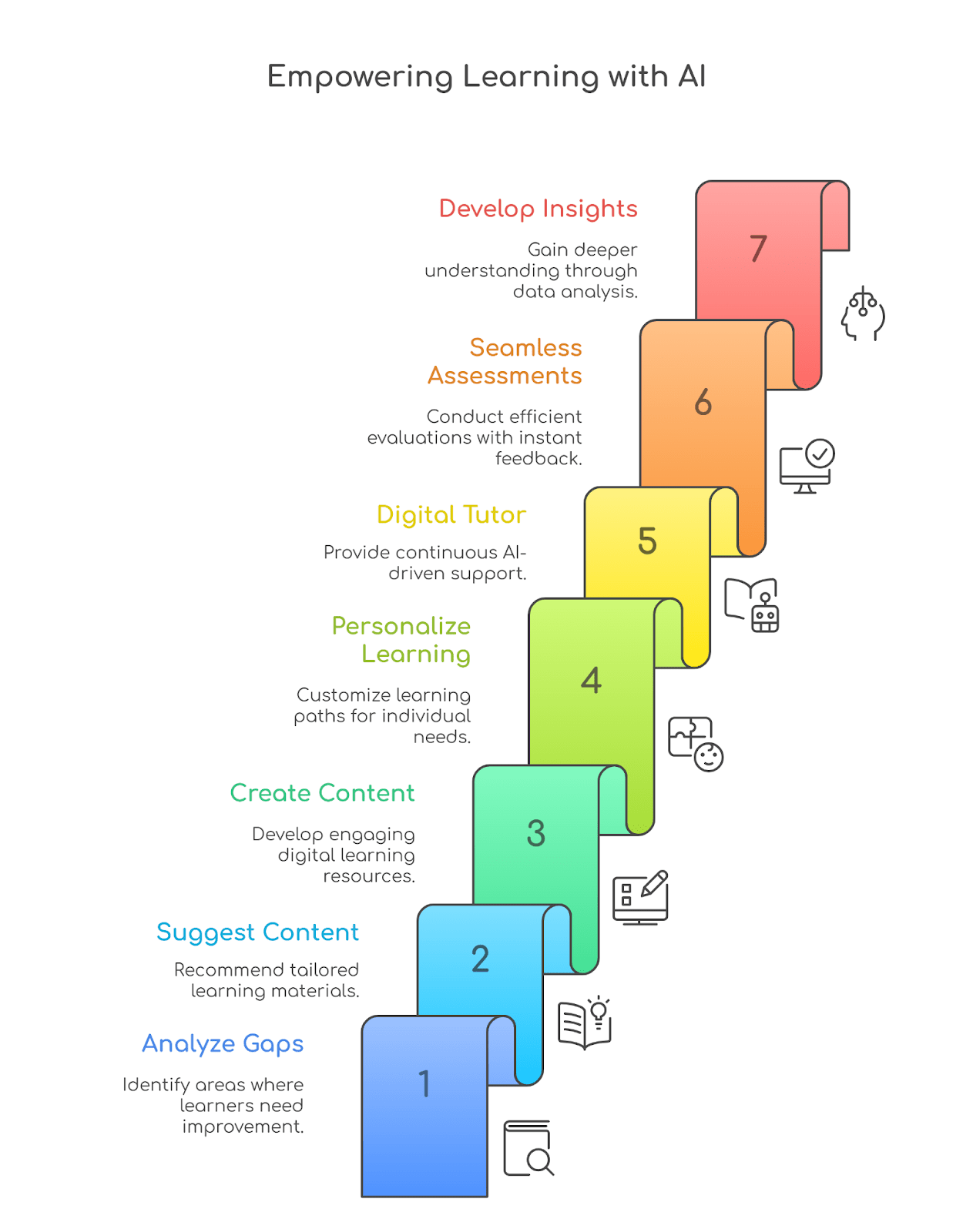
AI eliminates the need for a human trainer to some extent. Your employees may have many questions while training or taking a new course.
Most of these queries are common and standard for all learners. In traditional approaches, the employees would have to ask the trainer to resolve their queries, so they would have to wait for the trainer’s availability.
AI helps address these queries and even provides accurate answers.
Enterprises can use AI-based chatbots to help learners get answers to the most common questions. The whole process is done in human conversation, just as you would chat with a customer care representative.
With AI, enterprises do not need human efforts to assess learning. AI-driven tools can gather information, evaluate performance, check answer sheets, and provide accurate results. Employees can get feedback instantly and learn how they perform.
AI can be used to deliver any assessment as long as it’s digital. You can develop various assessment techniques and deliver them to your employees. Additionally, AI can even help personalize assessments. Most tests or quizzes are created based on a ‘one-size-fits-all’ approach. They don’t consider IQ, skills, or other such factors.
Using AI, employees can take tests based on their capabilities, skills, and learning levels. This creates a more accurate performance evaluation system and eliminates situations where some find the test too hard and others too easy.
Here’s how AI can gain important insights for you:
AI is actively shaping how students learn, teachers teach, and institutions scale. Let’s explore how real-life edtech platforms are leveraging AI to redefine Learning and Development (L&D)...
We collaborated with PhysicsWallah to integrate AI-driven analytics that personalize the learning experience for students across India. Basically, it figures out how each student ticks. The tech keeps tabs on what students are actually doing, where they’re struggling, and then, boom, serves up lessons and practice stuff that actually fits them. If you’re slacking in, say, Newton’s Laws? The system knows, and that’s what you’re gonna see.
Now, for Competishun, we built this adaptive test thing that’s pretty much like the Matrix for exams. The AI picks out questions based on how you’ve been doing, so if you’re acing it, you get tougher stuff; if you’re drowning, it throws you a life vest. Plus, you get feedback in real time, which, let’s be honest, is way better than waiting around biting your nails for results.
We set them up with an AI system that’s like Tinder for tutoring, swipe right for calculus help, basically. It hooks students up with the right expert, instantly. The system’s got these brainy filters that match your question to someone who actually knows what they’re talking about. On top of that, we tossed in AI tools to sniff out plagiarism and check if the content’s actually, you know, legit. No more sketchy homework help.
BYJU’S has really stepped up its game with AI integration. We worked alongside their team to embed machine learning models directly into their learning framework. It’s not just about delivering content anymore—the platform now tracks user actions, engagement, and learning patterns. This means lessons get adjusted in real time, offering each student material that actually fits their needs. The upshot? Learners of all ages are more engaged, and the content is far more effective.
Embibe is taking personalization seriously. They don’t just look at test results; their deep learning systems analyze things like how long a student takes on each question, how often they revisit certain topics, and where their accuracy stands over time. The AI delivers targeted feedback, helping students improve their speed, accuracy, and overall retention.
All in all, these platforms show that AI in Learning and Development isn’t just a theoretical idea, it’s already making a measurable impact. As these technologies advance, expect learning experiences to become even more tailored, efficient, and accessible.
As one of India’s fastest-growing EdTech platforms, Physics Wallah has consistently aimed to make education more accessible, affordable, and effective. To support their mission, we partnered with them to build a scalable, AI-powered learning ecosystem that could cater to millions of students across different academic levels.
Physics Wallah provides affordable and quality education to students from Classes 6 to 12, as well as aspirants preparing for competitive exams like JEE and NEET. With a fast-growing user base and expanding offerings, the brand needed a robust and intelligent tech infrastructure to deliver personalized and adaptive learning experiences at scale.
We worked closely with the Physics Wallah team to develop AI-first, learner-centric solutions designed to improve engagement, streamline content delivery, and provide tailored learning pathways for diverse student groups.
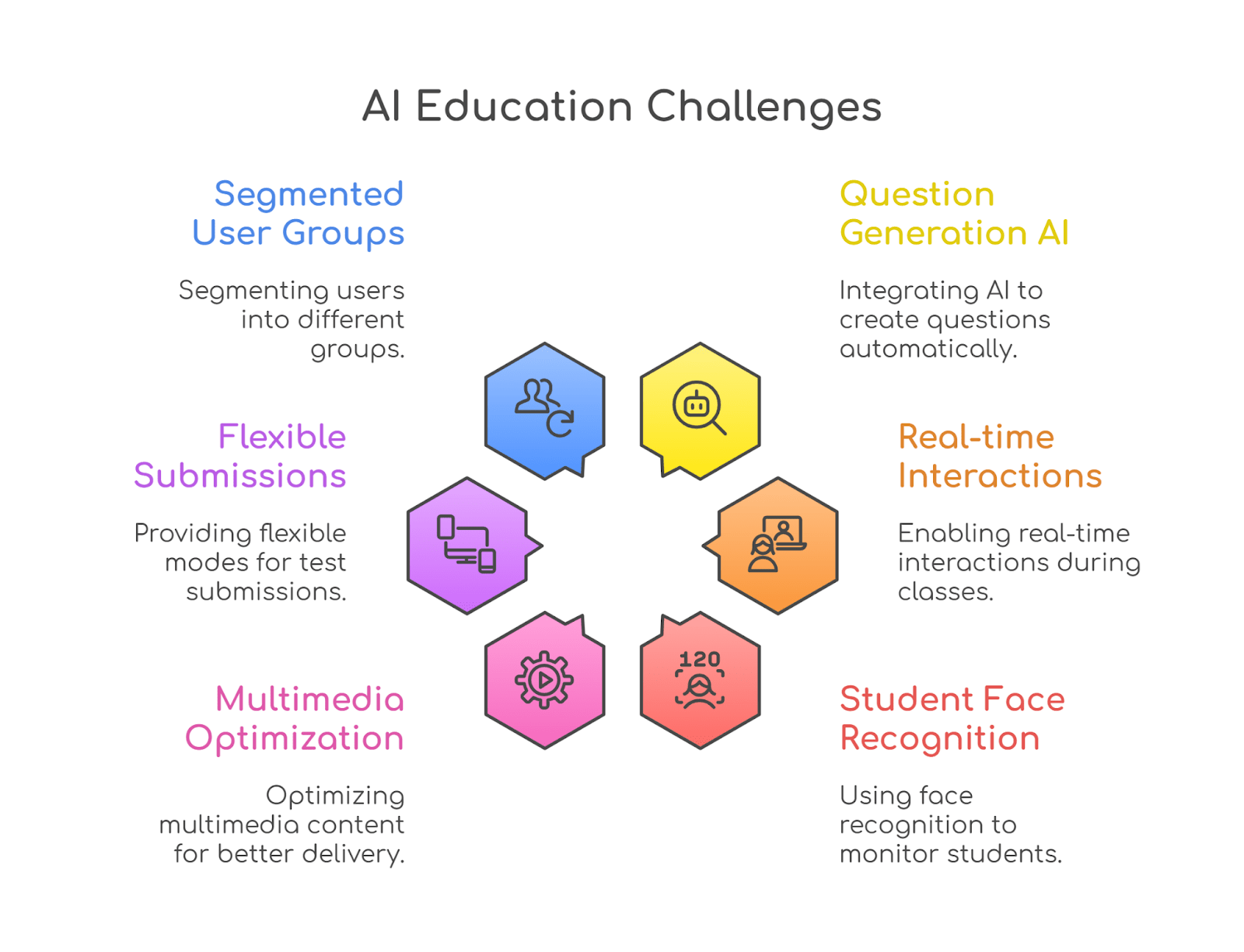
Developing a reliable Gen AI system to auto-generate questions relevant to a student’s learning path while maintaining accuracy and content quality.
Supporting live classes and chat features at scale, with seamless communication and minimal delays.
Implementing privacy-compliant face recognition technology to assess student attentiveness during sessions.
Ensuring smooth playback and performance of video, audio, and visual content across all devices.
Building infrastructure to support both online and offline test submissions across diverse learning environments.
Customizing the learning experience for different user segments such as general curriculum students and medical aspirants.
We developed tailored applications for general and medical students, allowing them to access content and assessments designed specifically for their needs and goals.
We integrated AI models capable of generating fresh, relevant, and difficulty-adjusted questions in real time, making the learning experience adaptive and engaging.
To support live classes and student-teacher interaction, we built a reliable backend using WebSockets, ensuring smooth and scalable communication.
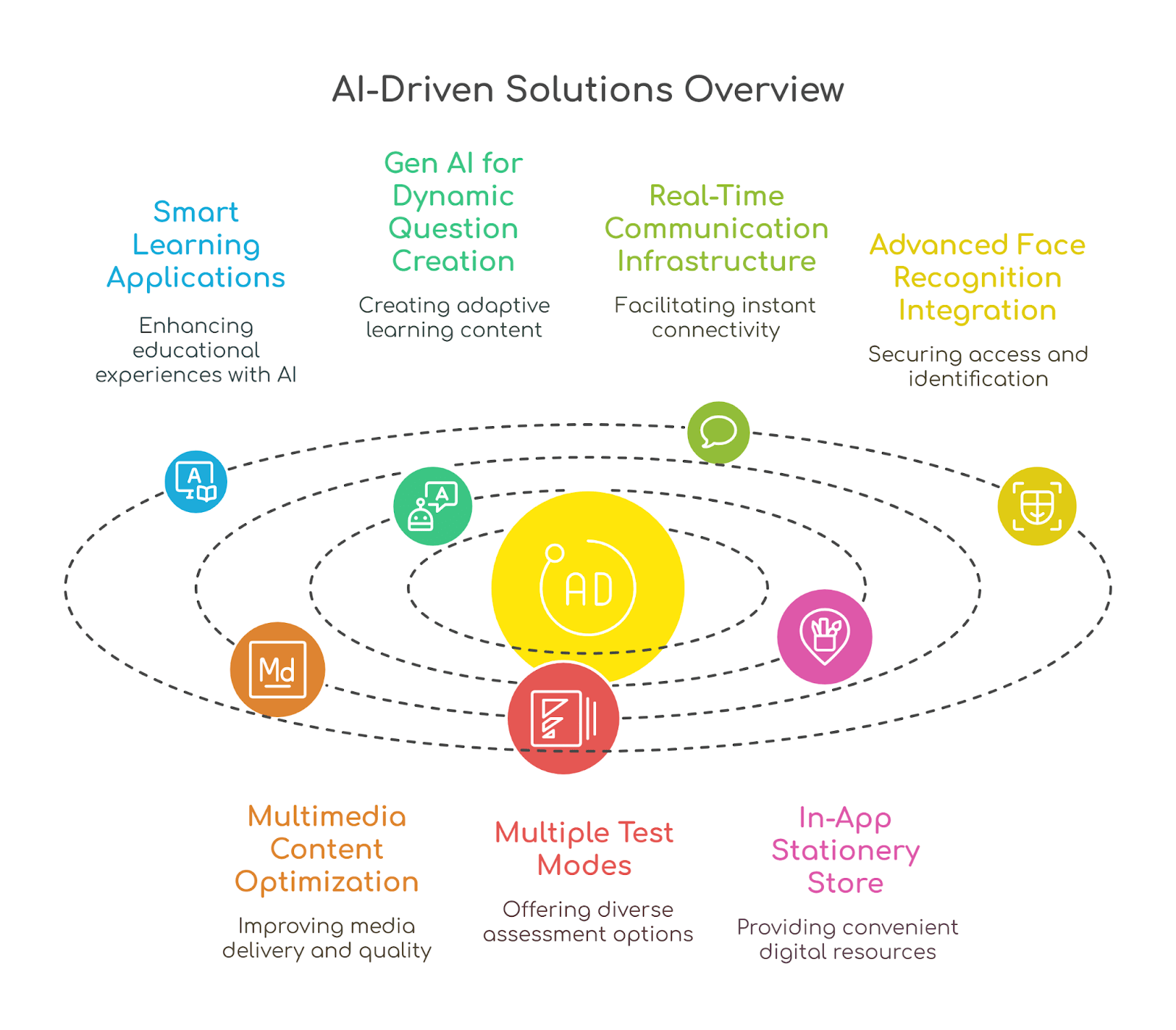
Our system enabled secure and accurate face recognition to monitor student presence and attentiveness while strictly adhering to data privacy norms.
We optimized the platform for seamless streaming of high-quality multimedia, ensuring smooth access even on low-end devices and slow networks.
We built functionality that allowed students to take and submit tests both online and offline, providing flexibility without compromising data accuracy.
To enhance user convenience, we integrated a store within the app, allowing students to order study materials and stationery directly.
Our AI-powered solutions helped Physics Wallah:
Our partnership with Physics Wallah is a testament to how AI, when implemented strategically, can transform the way learners engage with content and achieve outcomes.
Let’s get real—the Learning & Development field is in the middle of a major shakeup, and AI is steering the ship. The way people work is shifting fast, and employees expect more than the same old training modules. Artificial Intelligence is stepping up, making L&D smarter, more relevant, and a whole lot more tailored to each person. So, if you want the scoop on how AI is actually changing the game in corporate and institutional learning, here’s what’s making waves right now…
AI integrated with VR and AR is seriously transforming the way organizations approach training and development. Instead of outdated onboarding videos or risky hands-on practice, employees can now step into fully immersive environments without any of the real-world danger. The best part? AI tracks each person’s performance and adapts the experience in real time, making the learning process both safer and more engaging. It’s a smarter, more dynamic way to build skills, plain and simple.
AI is reshaping learning and development in a big way. It tracks each employee’s habits, preferences, pace—you name it—and customizes training to fit those needs. We’re moving away from cookie-cutter programs. In the near future, companies will lean even more on algorithms that adjust content in real time. Picture it: training that actually fits the individual, not just the job description. That’s where things are headed.
Microlearning is definitely on the rise, especially in the business world. With AI in the mix, we’re seeing complex subjects broken down into concise, easily digestible pieces—think training that actually fits into a packed workday. This approach not only streamlines learning but makes it far more practical for busy professionals who need to recall and apply new information on the fly. Honestly, it’s a smart shift for companies that want training to stick without eating up half the day.
With AI, personalization will involve learning styles, tone of delivery, assessments, and even feedback. Natural language processing (NLP) and learner sentiment analysis will allow AI systems to customize interactions with incredible precision.
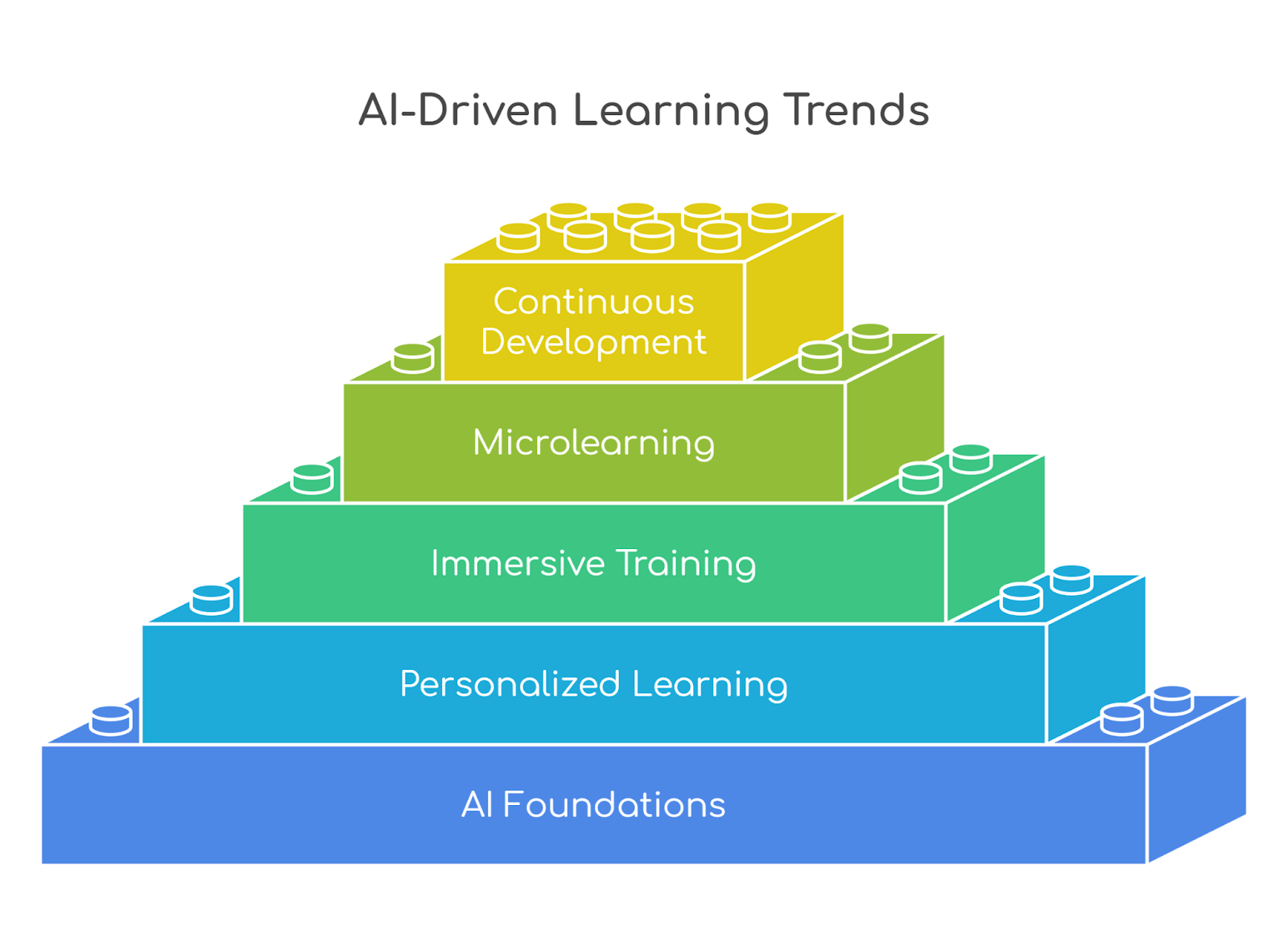
The future of L&D is integrated, not isolated. AI tools will deliver just-in-time learning nudges within employees’ existing workflows, whether it’s through Microsoft Teams, Slack, or an internal CRM, ensuring that learning becomes a seamless part of everyday work.
As job roles continue to shift, AI will proactively pinpoint skill gaps by scanning job requirements, performance metrics, and industry developments. With these insights, employees can receive tailored recommendations for upskilling and reskilling, ensuring they remain competitive and well-prepared for future changes in the workplace.
From intelligent content curation to automated assessment and performance analytics, AI and ML will power the backend of L&D systems, streamlining operations while improving learner outcomes. These systems will get better over time through continuous learning from user behavior.
Combining microlearning with AI creates hyper-targeted, easily digestible learning experiences. Based on past learning behavior, AI will suggest what to learn next, in what format, and at what time, leading to better knowledge retention and engagement.
These trends point to a future where learning is smarter, faster, and more human-centric, ironically, driven by machines. Organizations that adopt AI in L&D today are setting themselves up for a workforce that’s not just skilled, but adaptable, empowered, and future-ready.
Absolutely, Artificial intelligence is making serious waves in the learning and development sector. Forward-thinking companies aren’t hesitating; they’re leveraging AI to accelerate training, boost engagement, and streamline knowledge transfer. It’s not just a trend; it’s reshaping how teams learn and grow.
At Antino, we stand out in EdTech by combining deep industry knowledge with the latest AI innovations. Our platforms don’t just deliver content; they adapt dynamically to each learner’s pace, progress, and unique preferences. This personalized approach maximizes retention and keeps learners truly engaged.
Our experience speaks for itself; we’ve partnered with leading EdTech brands like Physics Wallah and have a strong foundation in mobile, cloud, and machine learning technologies. If you’re aiming for real impact and sustainable growth in EdTech, let’s connect. We’re here to help you build an AI-driven platform that actually delivers results.
